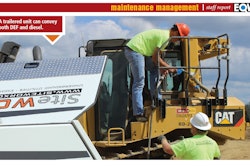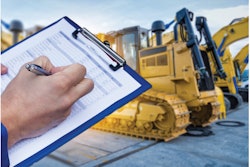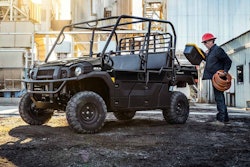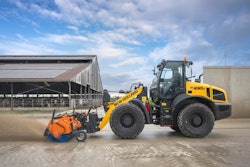
Even the best oil filter is of no use if the gasket/O-ring seal or media is brittle. If you store it at the wrong temperature, the wrong humidity or subject it to airborne dust and contaminants, it could be unfit for use or potentially cause bigger problems if you install it on a machine.
If you are in charge of a shop or maintenance facility, one of your critical duties is to get the right parts at the right price, at the right time – and keep them in the right condition.
A storeroom maintained at constant temperature and humidity provides an excellent environment for storage of MRO parts and provides a favorable work space for the storeroom staff. (MRO stands for maintenance, repair and operating supplies.) But maximizing lifespan and reliability requires planning and preparation.
Parts don’t have a red-light indicator or sensor showing when they have become defective or contaminated from the environment. But put a degraded component on a machine, and after installation, the red lights will glare.
Dust and airborne contamination
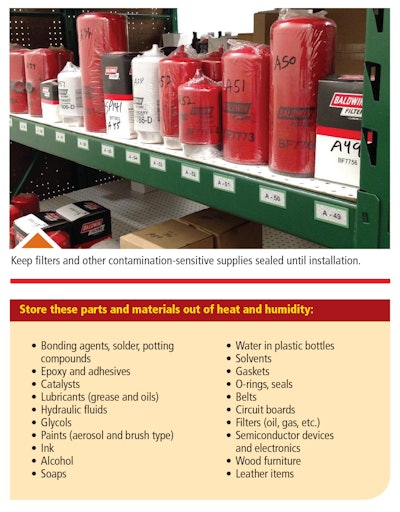
A storeroom next to the shop facility will be exposed to numerous sources of airborne particulate contamination, and they will find their way onto the parts and materials stored there. One solution is to wall off or relocate storage far from the repair facility, which can help control the environment around contamination-sensitive components such as those that go into closed-fluid systems. Other solutions include periodic dust removal and strategic placement of air purifiers with HEPA filters, but isolation and environmental control are recommended for more sensitive components.
Combating heat, humidity
Both heat and humidity accelerate the deterioration of certain parts and materials. (See sidebar.)
To reduce degradation, most of these items should be kept at a temperature of less than 80 degrees Fahrenheit and a relative humidity of less than 50 to 60 percent. In storerooms without significant air movement and cooling, the dew point becomes a factor when humidity levels exceed 60 percent.
Although warm air holds more moisture than cold air, it’s important to realize that the humidity of the air changes only as a result of a change in temperature. When air cools it becomes more humid, even though the moisture content in the air remains the same. As warm air cools, humidity rises and eventually reaches a point of condensation buildup on various surfaces like walls or stored items, which impacts component or material reliability.
Using temperature-controlled environments can extend the usable lifespan of compounded chemicals from the normal two years to as many as five years. The solution is to apply air conditioning and humidity control with desiccants or humidifiers, as well as use digital humidity and temperature monitoring tools for heat- and moisture-sensitive items.
Belt storage
Premature belt failure can often be linked to improper belt storage. By following a few common-sense steps, belts can retain their initial serviceability and reliability by avoiding:
• Hanging on nails or small diameter pins, as the weight of the belt could damage the tensile cord material. (If hanging is necessary, suspend the belts on a wall rack, saddle or large diameter tubular bracket to avoid crimps and deformation.)
• Direct sunlight (UV).
• Heat and humidity. (Store in a cool, dry place with environmental conditions below 80 degrees Fahrenheit and less than 70 percent relative humidity for a potential six-year shelf life.)
• Hanging variable-speed belts, as they are more sensitive to distortion.
• The use of ties or tape to pull belt spans tightly together near the end of the belt.
• Storing near radiators or heaters or in the air flow from heating devices.
• Storing where they are exposed to airborne solvents or chemicals.
Electric motor storage
Most electric motors are designed with grease-lubricated, anti-friction, rolling-element bearings. Bearing troubles account for 50 to 60 percent of all electric motor failures. Poor lubrication practices are the source of most of these bearing troubles; in fact, 80 percent of all bearings will never reach their life expectancy.
Damage to electric motor bearings can occur while a motor is in storage due to static corrosion from inadequate rust and corrosion inhibitors to protect the metal surfaces. Another potential problem is motor vibration that forces out the grease from between the rollers and raceways in the load zone, which also leads to rust formation on the metal surfaces.
False brinelling (a process of wear in which similar marks are pressed into the surface of a moving part) is an additional concern. Vibration of the bearing in a static position (non-rotating) causes the rolling elements to vibrate against the raceway in one place. Over time, the vibration can remove miniscule pieces or particles of metal surfaces. This is evident when wear marks line up with the spacing of the rolling elements.
Initial greasing is good for 12-month storage, but to prevent these other types of damage, you should attach tags to the motors that state, “Grease during installation.” Also, fully grease rebuilt motors or removals arriving into storage and purge motors that have been idle for years of dried grease slugs.
Do not use EP grease in motors. Clean the areas around the relief and fill fittings, then unscrew and remove the grease relief valve or drain plug (grease outlet plug) at the bottom of the motor.
Grease the bearing with a set amount of grease according to the manufacturer’s recommendations. Slowly add grease (10 to 12 seconds for each stroke) to minimize excessive pressure buildup in the grease cavity. Keep in mind that the standard manual grease gun can produce pressures up to 15,000 psi, while most seals can pop at 500 psi.
After excessive grease has been purged, reinstall the drain plug, clean excessive grease from the relief port area and wipe the grease fitting.
Tag the stored motor with the date of last lubrication and the lubricant type.
Store motors in a clean, dry, vibration-free area. Use pieces of used conveyor belt as isolation padding between the motor and a wood skid or floor. This insulates the motor from the effects of vibration and harmonics from fork lifts and other sources of floor vibration.
Rotate idle motor shafts every other month or quarterly to redistribute grease and maintain a corrosion-preventive film on bearing surfaces and prevent false brinelling. There are visual aids to help with this task, as illustrated in the photo on page 38 from swspitcrew.com. The target aids are stuck to the end of the shaft or fan and rotated two full rotations and set to a color wedge. You can even assign colors to a given month. A PM can be generated to trigger this activity.
Parts that need storage attention
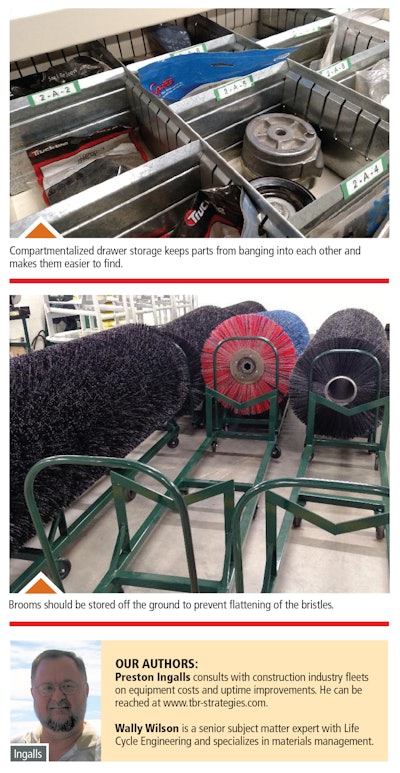
Pneumatic valves. Large pneumatic valves should be cycled at least quarterly to prevent damage to the seals and valve seating surfaces
Rubber components, including V-belts, cog belts, gaskets containing rubber compounds and O-rings. Belts should be managed by the date received, first-in, first-out. Belt replacement on operating equipment should be a scheduled PM activity.
Electronic boards and components. Store in an environmentally controlled space when possible. Drive boards can be damaged by exposure to extreme environmental conditions such as dust, static, heat and humidity. Drive boards should be stored in the appropriate static bags, and anytime the board is removed from the static bag, a new bag should be used if it is put back on the shelf.
Gearboxes and pumps should be under a scheduled PM program that includes lubrication and exercising of the bearings to prevent brinelling and static corrosion. These components should also be stored on vibration dampening pads and large gearboxes blocked to prevent damage to the bearing and raceway. Gearboxes and pumps should be under a 90-day PM schedule.
Pneumatic and hydraulic cylinders should be under scheduled PM with the openings capped to prevent contamination. Large pneumatic and hydraulic cylinders should be stored vertically to prevent damage to the actuator seal. Cylinders should be stored with the base down and the actuator up. Secure to prevent falling.
Inventory shelf life
Establishing a spare parts management policy of first-in, first-out (FIFO) ensures the oldest parts are used first. Include a date received on the inventory tag or write a date on the packaging to ensure the person picking the items can pull the items by received date.
The use of high-density storage cabinets provides additional protection from dust and exposure to UV lights that can accelerate the degradation of many of the parts stored. Component manufacturers and OEMs typically publish their recommend storage procedures.
–Preston Ingalls and Wally Wilson




